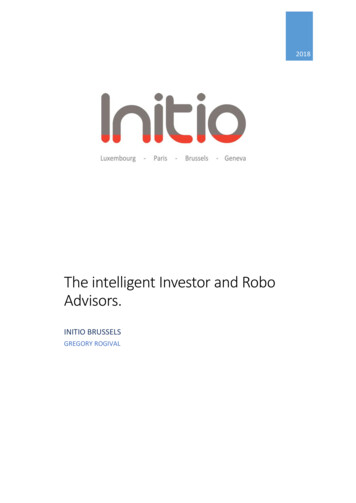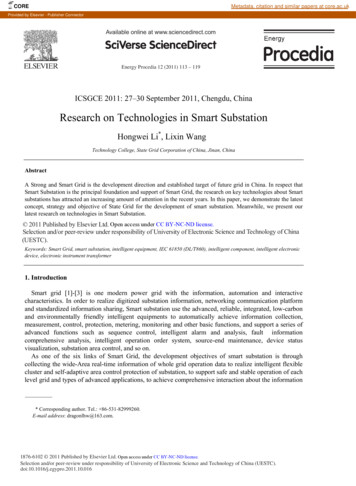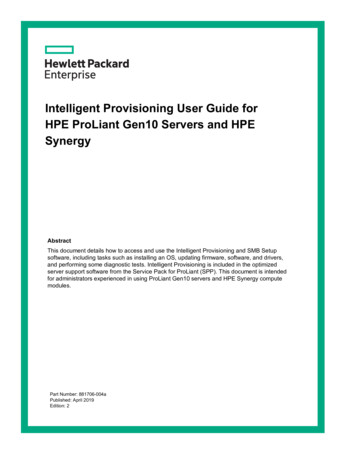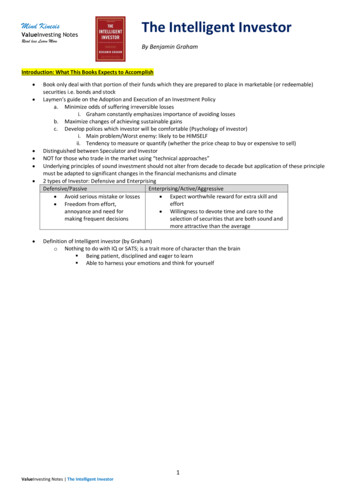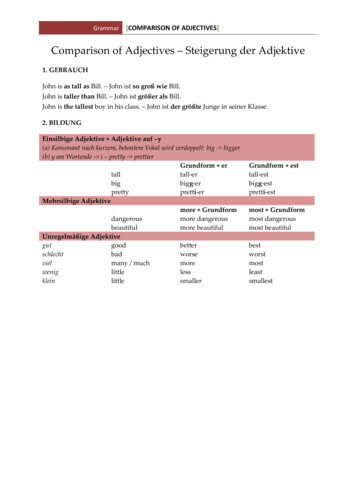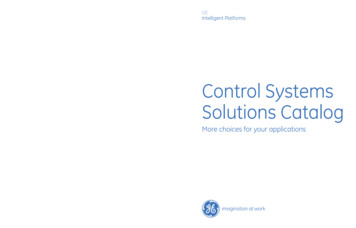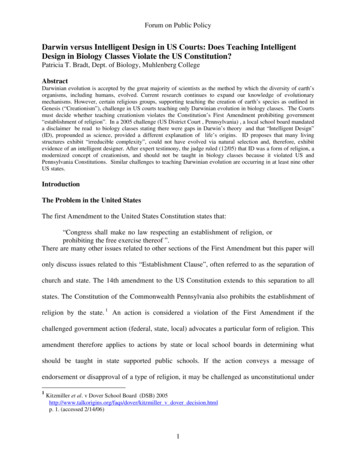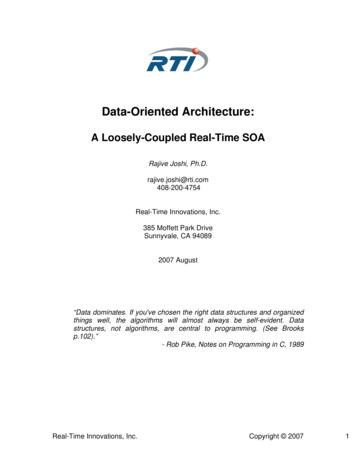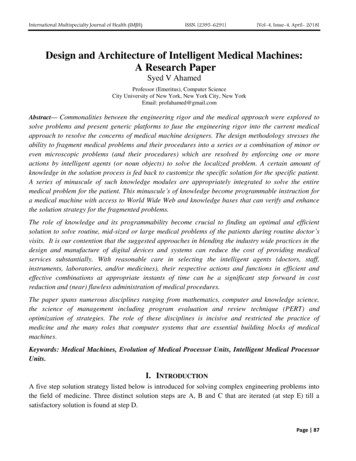
Transcription
International Multispecialty Journal of Health (IMJH)ISSN: [2395-6291][Vol-4, Issue-4, April- 2018]Design and Architecture of Intelligent Medical Machines:A Research PaperSyed V AhamedProfessor (Emeritus), Computer ScienceCity University of New York, New York City, New YorkEmail: profahamed@gmail.comAbstract— Commonalities between the engineering rigor and the medical approach were explored tosolve problems and present generic platforms to fuse the engineering rigor into the current medicalapproach to resolve the concerns of medical machine designers. The design methodology stresses theability to fragment medical problems and their procedures into a series or a combination of minor oreven microscopic problems (and their procedures) which are resolved by enforcing one or moreactions by intelligent agents (or noun objects) to solve the localized problem. A certain amount ofknowledge in the solution process is fed back to customize the specific solution for the specific patient.A series of minuscule of such knowledge modules are appropriately integrated to solve the entiremedical problem for the patient. This minuscule’s of knowledge become programmable instruction fora medical machine with access to World Wide Web and knowledge bases that can verify and enhancethe solution strategy for the fragmented problems.The role of knowledge and its programmability become crucial to finding an optimal and efficientsolution to solve routine, mid-sized or large medical problems of the patients during routine doctor’svisits. It is our contention that the suggested approaches in blending the industry wide practices in thedesign and manufacture of digital devices and systems can reduce the cost of providing medicalservices substantially. With reasonable care in selecting the intelligent agents (doctors, staff,instruments, laboratories, and/or medicines), their respective actions and functions in efficient andeffective combinations at appropriate instants of time can be a significant step forward in costreduction and (near) flawless administration of medical procedures.The paper spans numerous disciplines ranging from mathematics, computer and knowledge science,the science of management including program evaluation and review technique (PERT) andoptimization of strategies. The role of these disciplines is incisive and restricted the practice ofmedicine and the many roles that computer systems that are essential building blocks of medicalmachines.Keywords: Medical Machines, Evolution of Medical Processor Units, Intelligent Medical ProcessorUnits.I. INTRODUCTIONA five step solution strategy listed below is introduced for solving complex engineering problems intothe field of medicine. Three distinct solution steps are A, B and C that are iterated (at step E) till asatisfactory solution is found at step D.Page 87
International Multispecialty Journal of Health (IMJH)ISSN: [2395-6291][Vol-4, Issue-4, April- 2018](A) The iterative procedure (i.e., solve once with initially guessed (or current) intermediate parameters(based on historical data about the problem), followed by solve again after step (C),(B) The process of relaxation of the constraints,(C) Four stepwise sub procedures are:C.1 {(move forward towards the solution) C.2 (gather knowledge gained) C.3 (analyze cause-effect relationship(s), if any) C.4 (adapt/reject/modify and iterate), and take the next localized step at C.1}(D) Verify if a satisfactory solution is reached after (C); If so Stop(E) Else Iterate back to steps (A), (B), or (C).The processes (A) and (B) proposed is based on Southwells’ relaxation techniques in the numericalsolution of engineering problems. The processes and sub processes in (C) are based on the PeterDrucker’s suggestions (Plan Organize Staff Implement Control( )Repeat & iterate) forProject Management.In reality, medical problems are more complex than numerical problems where Southwells’ solutionmethodologies are applicable or project management issues where Drucker management strategies areapplicable. In the medical domain, a direct superposition the principle of relaxation atop managementstrategy or vice versa, is not immediately feasible at a macroscopic level.However, the fusion of the concepts embedded in these two powerful approaches is possible at alocalized, microscopic level. When problem is so finely partitioned/divided and relaxation/strategy isequally well-partitioned/divided, then micro-surgery to the subdivided problem areas with the delicateinstruments of relaxation/strategy becomes feasible. A micro step in the solution of the problem is thusachieved. A series of such micro steps are reassembled from the guide lines derived from the AIconcepts embedded in Box 3.To the extent the processes of partitioning/division are feasible, their converses processes ofamalgamation/incorporation are also viable; much like differentiation and integration are two distinctmathematical procedures practiced by mathematician in the conceptual space.1 In localized andmicroscopic domains, the conceptual linkages are proposed in the medical domains. The appropriatematching of the objects and their functionalities would be impossible without the rules of ArtificialIntelligence embedded in Expert Systems, Pattern Matching, Computer Vision, Intelligent Agents andthe associated surgical micro instruments of AI.In an integrated sense, it becomes feasible to perform a type of differential analysis formulation in thefinite difference form in the medical field by solving micro medical problems and then performing atype of contour integration to solve the overall medical ailments of the patient(s). The matching andfunctions of objects and function can be best organized by the PR and ES programs borrowed from the1 In the practical application, the differential equations (generally Maxwell’s or fluid flow equations) are approximated as finitedifference equations and integral equations are approximated as corresponding contour integral equations.Page 88
International Multispecialty Journal of Health (IMJH)ISSN: [2395-6291][Vol-4, Issue-4, April- 2018]Science if Artificial Intelligence. Very competent doctors perform these rather diverse functions quitecoherently in their minds from the knowledge(s) acquired from their education, training, internship,experience and interpersonal skills. Yet every doctor is not as disciplines as a “virtual doctor” whopractices “perfect” forms of these doctorial education, training, internship, experience and interpersonalskills. The Image of this “virtual doctor” is hypothesized by intelligent network computers that scanthe Internet constantly for the cure every possible ailment on a collective and on an individual basis.Artificial intelligence in medicine has prevailed since the seminal contribution MYCIN1 type ofcomputer-based medical consultations programs that could be implemented on early computers of the1970s and 1980s era. Rule based expert systems have evolved as heuristic programming projectsinitiated at Stanford University in 19842 and entered in the realm of cognitive sciences.3 These seminalcontributions have become the cornerstones in scientific research since the 1990s. The present paper isfounded on the principles well established in most of computer science books and the AI books of the21st century.II. COMPUTATIONAL FRAMEWORK FOR THE PROPOSED METHODOLOGYThe steps A through E are depicted in Figure 1. The mapping of the software to track the methodologyis by superposing the steps into Boxes 1 through 7. The Universal of concepts from Southwell’s andAllen’s4,5 are blended with the modern AI techniques6 in Box 3 and with the Knowledge Age tools andnetworking topologies7 in Box 5. Peter Druckers’8 contributions in mixing and merging of relaxationprocedures with the AI techniques are deployed to making the process smooth and error free to a greatextent. In a sense, all the processes in Figure 1 can be construed as Southwells’ and Allens’ relaxationtechniques but with the more recent inclusions of AI based Inference Engines, Expert Systems 6 andwith modern intelligent Internet knowledge machines and their networks.7 The entire process requiresthe Internet access, support and switching support7 represented in Box 5 of Figure 1.Figure 1Schematic for the Solution of Major Problems in Engineering or Medicine based on aKnowledge Platform. (The symbol i represent the current iteration for the solution)Initial InformationKnowledge aboutProblem (if any)Start1Acquire RelevantLocal ProblemAssociated Informationor Knowledge ( i 1 )Southwell & Allen [4]AI Based Inference [6][6]Engines [3]Relax Constraints and 2Causes Associatedwith the Problem in the(Current iteration i)Deduce or VerifyEffects of theCurrent iteration (i)45ApplyStepwiseChanges7StrategizeStep i withChangesDrucker: Practice ofManagement [8]6InternetBased Info/knowledge3Noi i 1Knowledge AgeTools [7]Satisfactoryor OptimalSolution?YesStopHuman orMachine BasedPage 89
International Multispecialty Journal of Health (IMJH)ISSN: [2395-6291][Vol-4, Issue-4, April- 2018]The iterations in the closed loops in Figure 1 are indicative of the “trial and error” approach in thesolution of human problems in the social domain long before 1940’s when relaxation techniques wereintroduced. The classic contributions of Southwell and Allen imported the wisdom of “trial and error”methodology into mathematics and the numerical solution of engineering problems.2.1Blending Engineering Approach with Medical FunctionsThe treatment of patients is a scientific process in a great majority of the cases. Intuition of doctors,though not completely scientific, should be considered as what a machine can with endless search onthe Internet. After all machines, however scientific cannot compete with an expert human, even thoughthey can verify, build upon or even reject an intuitive decision. In a generic sense, numerous objects(such as doctors, medical staff, patients, patient family, treatments, medicines, medical tools, etc.) allplay specific roles. These roles are indeed functions that influence the goal of resolving the patients’needs. Specifically, such functions can be a prescribing treatments, medications, procedures, etc., thatare in the doctor’s domain; functions such as taking blood samples, blood pressure readings, injectingmedications, etc., that are in the medical staff domain; billing, accounting, collections, etc., that are inthe clerical domain; etc. Further, each of the functions is specific to the patient, the medical condition,the stage of treatment, the prior experience, etc. Hence, an elaborate linking and collaborating becomesnecessary for every object to accomplish the specific function in a chain of functions that lead to theaccomplishment of the overall goal. Such linking and collaboration can be called a “Convolution”between any object(s) and function(s) and conversely between any function(s) and the associatedobject(s).Such objects, functions and convolutions exist in engineering projects as well. For example, building ahouse, manufacturing a car, driving a car, etc., all have (major and minor) objects, (major and minor)functions, and (simple and complex) convolutions to accomplish their respective goal(s). Themethodology that is generic and standardized in the engineering field (such as computer aided design,computer aided manufacture, inventory control and accounting, etc.) can be imported in the medicalfield with due consideration the most objects in the medical domain are human and subject to abehavioral mode rather than a mechanistic or mathematical mode. Such consideration(s) make thecomputerization and optimization medical processes more complex rather than impossible. Hence itis our contention that the medical field can be only partially computerized.2.2Integrating Engineering with Medical ScienceIn perspective, it becomes feasible to perform a type of differential analysis formulation in the finitedifference form in the medical field by solving localized micro medical problems and then performing atype of contour integration to solve the overall medical ailments of the patient(s). The matching andfunctions of objects (doctors and medical staff) and (their positive healing and coordinating) functioncan be best organized by the PR and ES programs borrowed from the Science if Artificial Intelligence.Very competent doctors perform these rather diverse functions quite coherently in their mind from theknowledge(s) acquired from their education, training, internship, experience and interpersonal skills.Yet every doctor is not as disciplined as a “virtual doctor” who practices “perfect” forms of thesedoctorial education, training, internship, experience and interpersonal skills.Page 90
International Multispecialty Journal of Health (IMJH)ISSN: [2395-6291][Vol-4, Issue-4, April- 2018]The image of this “virtual doctor” is hypothesized by intelligent network computers (see Box 5 inFigure 1) that scan the Internet constantly for the cure every possible ailment on a collective and on anindividual basis. Perhaps it is one of the responsibilities of the world health organizations and worldclass universities is to contribute to the “personality” or the (grandiose knowledge base(s)) of thisvirtual doctor. Dedicated computers that scan the tax returns of millions of citizens perform suchfunctions by scanning for cheaters hiding behind their tax returns. A positive and humanitariannetwork is the proposed network of intelligent medical computers that will attempt to solve or resolveproblems that are to classified as insolvable. The methodology proposed is generic for numerousproblems that arise in global, social, medical and international domains.2.3The Role of Knowledge in the Medical FieldTwo distinct types of knowledge become eminent; (a) knowledge based on medical sciences and (b)knowledge associated with the patient and problem. When type (a) knowledge is carefully convolvedwith type (b) knowledge, then certain incremental or eventual step can be achieved in reaching the goal,but only with a certain probability since the behavioral mode can only be assessed on a statistical basis.In this paper we propose to extend the two approaches into the medical field by streaming the doctorpatient interaction by solving the medical problem(s) of the patients by the doctor in the three AIprocedures covering the (a) Diagnosis cycle, the (b) Prognosis cycle and the (c) Treatment cycle. Theconvergence of these three cycles is interactive and inter-dependent as the doctor-patient interactionemerges and leads to a near “perfect” solution.The structure of knowledge plays an important role. If a solution is reached in (re)solving amicroscopic medical problem, then a micro-element of knowledge (μk) is gained, that ties (convolutes;convolution is symbolized as *), a certain micro-object (μno) performing a micro-function (μvf) at acertain instant of time (or circumstances) or over a duration t. Stated alternatively, the generic form ofthis “event” over a period t is written as:(μk) (μno *μvf). t((μk)t t) / t (μno *μvf) t t/2Energy spent in accomplishing the function μvf is expended in the environment by one or more of thenoun objects2. More precisely the later equation should be written as𝑡2(𝜇𝑛𝑜𝑡1𝑡 𝜇𝑣𝑓 𝑡 ) . dt { (μk)t t - (μk)t }And interpreted to read that the gain in an increment of knowledge over a period (t2 minus t1) is due anintegrated effect (*) of the event encompassing an action (vf by a noun object no, or vf upon a nounobject) between (μno and μvf), (μvf and μno) or a chain of such events. This representation makes it2These equations imply the flow of knowledge power and knowledge energy. Knowledge power should be considered as the “power”of impact of (no*vf). If this power of impact is integrated over finite time or circumstances then a certain quantity of knowledgeenergy accrues. In practice, the knowledge energy is only gained or lost. It is indeed the change of the state of knowledge since wedo not have a state of zero-knowledge. Hence a certain amount of caution is necessary to interpret the equation in a strictlymathematical format, but it is possible to estimate the change ( k) in a computational framework.Page 91
International Multispecialty Journal of Health (IMJH)ISSN: [2395-6291][Vol-4, Issue-4, April- 2018]possible for the events during a series of t periods can be represented as a series of equations on paperor a series of executable commands to a computer system. Medical programming becomes feasible asa series of executable statements on a medical computer or machine. Such medical programs can beconstituted, grouped, chained or cascaded like macros and/or subroutines in computer software.Much like any systems programming projects, major medical events are amenable to PERT and CPMtools in Management systems.9 The ambiguity behind the medical treatments is thus resolved bymanagement tools and engineering optimization techniques. The unification of the two majordisciplines is likely to save the medical costs to the patients and insurance companies by at least 50percent.Programming the micro and macro noun objects ( 𝜇𝑛𝑜′ 𝑠 𝑎𝑛𝑑 𝑙𝑎𝑟𝑔𝑒 𝑁𝑂′𝑠) and their correspondingmicro and macro verb function (𝜇𝑣𝑓 𝑎𝑛𝑑 𝑙𝑎𝑟𝑔𝑒 𝑉𝐹′𝑠) to act coherently in coordination (*’s) atpredefined instants of time (t1, t2, t3, etc.) will facilitate major medical events (such as (heart, kidney,bone marrow, etc.) transplants and or other surgical events become (almost) error free.III. SUPERPOSITION OF KNOWLEDGE SCIENCE ON THE AI FRAMEWORKKnowledge science methodology that could be implemented by computer architectures was conceivedand presented10 as far back as 1993 and 1994. Knowledge science as a scientific discipline waspresented in 200611 and further expanded in 201412 based on the theory of knowledge.13 Theconvergence of knowledge science, computational programming and its machine implementation asthey can be implemented in the Science of Medicine was presented in 2013.143.1Medical Science as a Part of Knowledge ScienceKnowledge is computational entity that can be processed as numerical, logical, and/or informationalentities in computers and networks11 The command languages and processing architectures forknowledge systems become progressively more intricate, elaborate and structured [see Chapters 5, 6and 7 in Reference 11]. Though more complex knowledge processing systems can be construed andbuilt dependably as the knowledge bases and knowledge management systems now distributedthroughout the World Wide Web (WWW) sites. Even though such knowledge systems do not functionas precisely, accurately and dependably as the more established computer systems, they perform moreprecisely, more accurately and more dependably than the human counterparts who also processknowledge in finding one or more solutions to the real problems in life and society.A frame work of measuring, quantifying and predicting knowledge in any particular direction definedby the Dewey Decimal Systems or the Library of Congress classification is presented in Reference '12'.Knowledge centric objects (KCOs) can indeed be constructed in the memory systems of computers.These KCOs have volatile and dynamic boundaries that couple with the human mind/ psyche or withother KCOs to image the reality of the physical space. The attributes and bondage of the KCOs arealtered by the knowledge systems much as the numerical values and their dependencies are altered bythe CPUs and programs of computers.Page 92
International Multispecialty Journal of Health (IMJH)3.2ISSN: [2395-6291][Vol-4, Issue-4, April- 2018]Expansion of Knowledge Science into the Medical DisciplineThe concepts from references '10 and 11' are explored and expanded further in Reference '13' andcorrelated to the basic human needs that offer the raw motivational energy to drive the actions thatmanipulate the KCOs. These altered stated of KCOs gratify the human needs that prompted the action.A state of temporary equilibrium is reached for that particular need till the next deficit need promptssimilar action. The cycle continues and the focus of lives of all organism moves from one instant to thenext. Machines can indeed track such movements and optimize the strategy for efficient andmeaningful life of the user of such mini-machines. For more complex and deeper problems, themachine architectures and the processing of the KCOs can be conceived, designed and built from theVLSI chips14 that image the social and cultural environments of human setting.3.3Medical Knowledge and Doctor Patient RelationsBased on the science of organizing, arranging and architecting of knowledge, a fundamental theory ofknowledge is constituted.15 The general theory of knowledge is based the truism that any action that isassociated with an object changes its status. It is also because actions cause change. An action that doescause any change in the entropy anywhere in the system is no action at all. Since there is no object thatdoes not undergo change, there is some action or a set of actions inherently and inadvertently actingupon every object. An object without one or more verbs to act upon it is a non entity and a verb withouta corresponding noun to be acted upon is virtual. These truisms are applicable in the medical field aswell; to the extent a medical process (or any process) can cause a change in the status or condition of apatient. We map the medical functions of the doctors to the corresponding effect (both positive andnegative) on the status (medical condition) of the patient. Objects in nature and their inevitable changesare the basis of theory of knowledge in every discipline including the medical field. Changes occurover measurable and discernible parameters. Changes that cannot be perceived over a predefinedduration should be considered as no change or deductively, the action that was to have caused thechange is ineffective.In the real world, the innate forces of nature/environment and the rate of change that lead to the causeand intensity of such forces. In social settings, the hierarchical needs based on Maslow’s Motivationaltheory of needs of humans that exert such forces. On a broader scope, the physical laws (e.g.,gravitation, electromagnetic and electrostatic, etc.), quantify such forces. Indeed, the natural processesbecome the theme to construct the theory of cause and effect relation in medical sciences. Thevalidation of the normal, the usual equations relating the measurable parameters (such as, mass andmomentum, force and movement, torque and rotation, energy and inertia, etc.) becomes necessary. Asthe real objects fill the physical space; hypotheses, concepts, and notions fill the intellectual space;humans, their needs, and their innovations fill the social space. One of the objectives of the theory is toextend the domain of (statistical and probabilistic) computation coupled with the inference anddirectionality offered by AI techniques to extend the frontiers of knowledge and to derive notionsleading on to concepts and axioms leading on the wisdom and practice of the medical sciences.Page 93
International Multispecialty Journal of Health (IMJH)ISSN: [2395-6291][Vol-4, Issue-4, April- 2018]IV. EVOLVING ENHANCED MEDICAL MACHINE ARCHITECTURESA series of Figures 2 through 5 illustrates the migration of architectures of simple computers from theirconfiguration (Figure 2) to those of an enhanced medical computer (Figure 5). The step-wise migrationenhancement of the functions is embedded in the functions of the CPU (central processor unit), theKPU (the knowledge processor unit), the MPU (medical processor unit) and the EMPU (enhancedMPU). The two additional stages become necessary: a knowledge based computer that performs theoperational code (opc) for the microcode to accomplish a verb function (i.e., equivalent of a knowledgeoperation code kopc) between a noun object (i.e., no) and its verb function (i.e., vf) in an appropriatesyntax (i.e., * that precedes or follows any typical no or a typical vf).No convolution can exist without a driving noun or source of energy and its corresponding action orfunction. By the same token, each and every action or function causes the change of status of nounobject(s) and a corresponding convolution or * is associated. Correspondingly, a * before or after anaction of verb function(s) indicated the modality of the verb. These contextual relationships betweenverb function(s) and noun object(s) are part of the executable code of all computers and machines foroptimal accomplishment of the goal of the entire and overall program.4.1The Plain Old Computer ArchitectureThe bus architecture and the CPUs architectures of the simpler computer have evolved dramaticallyover the last few decades. Both architectures are portrayed in Figure 2 and 2A respectively. The busarchitecture of Figure 2 is able to accommodate the CPU in Figure 2A for an early inexpensivemachine.Figure 2. The Architecture of a typical computerwhere the CPU performs the routine processingfunctions including those of the Arithmetic-logicunit (ALU), the indexing, memory access andInput/output (I/O) functions.Figure 2A Microarchitecture of a duoprocessor from the 07-08 period. Two CPUsare integrated with a GPU and two channelDirect Memory Interface for faster Graphicaldisplays.Page 94
International Multispecialty Journal of Health (IMJH)4.2ISSN: [2395-6291][Vol-4, Issue-4, April- 2018]The Knowledge Machine ArchitectureThe architectural arrangement of a knowledge machine is shown in Figure 3. The KPU (enhanced froma CPU) executes kpoc assembly level instructions on nos and vfs much as a typical CPU executes anopc instructions on its appropriate operands. The associated functions (such as fetching the operands,store the result, indirect addressing, indexing, etc.) become more detailed and cumbersome but orderlyand programmable. Such functions are feasible in HW or micro-code as they are feasible in hardwiredCPUs or in micro memories in the VLSI design of micro-programmable CPUs.Figure 3. (Left) The Architecture of Knowledge Machine (KM)where the KPU performs the Knowledge Functions in addition tothe functions of the CPU. Multiple CPUs may also be distributedthroughout the KM for specific CPU functions germane to theknowledge functions (such as computing the probabilitydistributions, or confidence within a decision making process.Figure 3A (Below) Switch S-1, Open for Execution Mode forKnowledge Domain Problem Solving; Closed for Learning Mode.The Learning programs 'process' the existing solutions and areable to extract objects, groups, relationships, opcodes, groupoperators, modules, strategies, optimization methodologies fromexisting solutions and store them in object and correspondingdatabases. The architecture permits the KPU to catalog a newobject in relation to existing objects and generate/modify existingpointers to and from new objects.4.3The Medical Machine ArchitectureThe architectural arrangement of a simple medical machine is shown in Figure 4. The MPU (enhancedfrom a KPU with additional CPUs) executes mpoc assembly level instructions on medical nos (medicalnoun objects) and mvfs (medical codes and/or much medical verb functions) as a typical KPU executesPage 95
International Multispecialty Journal of Health (IMJH)ISSN: [2395-6291][Vol-4, Issue-4, April- 2018]a kopc instructions on its appropriate medical operands that will receive the effect(s) of the mpoc(s).Functions associated with MPUs become at least an order of magnitude more complex than those of theKPUs and even two orders of magnitude more complex than those of the CPUs. It becomes logical tosupport the MPU(s) with slave KPUs and slaves of MPUs and KPUs. With the rapidly diminishedcosts of the VLSI circuit components in the 21st century, the cost of an MPU gets comparable to thecost of a typical mid-sized CPU during the late 1960s.Figure 4 The Architecture of Medical Machine (MM) where the MPU performs the Medical Functions inaddition to the functions of the KPU and the CPU. Multiple KPUs and CPUs may also be distributedthroughout the MM for specific medical functions germane to the medical environments (such as computingthe optimal use of a certain specific drug or treatment, or confidence within a medical decision makingprocess, such as the deployment of transplant process, etc.).Figure 4A Architecture of a medical processor unit (MPU). DMA direct memory access, DBMS Data,base management system that holds procedure, patient and/or attribute base(s), procedure managementsystem(s), patient specific characteristics, and medical resources of the hospital, KB knowledge base(s). Themedical procedure code is the ‘mopc’ that forces the MPU to execute a micro or nano medical function.Page 96
International Multispecialty Journal of Health (IMJH)4.4ISSN: [2395-6291][Vol-4, Issue-4, April- 2018]The Enhanced Medical Machine ArchitectureThe architectural arrangement of enhanced, elaborate and extended medical machines is shown inFigure 5. The EMPU (enhanced from a MPU with additional KPUs, and CPUs) executes mpocassembly level macro instructions on medical hierarchical hnos (complex medical noun objects) and/orhierarchical hmvfs (complex medical codes and/or hierarchical medical verb functions) as a typicalMPU executes mopc instructions on its appropriate medical operands that will receive the effect(s) ofthe hmpoc(s). The presence of the complex medical codes and complex verb function is made feasibleby assigning a tree/graph structure to each of the hmnos and hmvfs. It is still to be evaluated if the m*’salso need a tree/graph structure. These medical machines will facilitate the work of physicians as muchas computer aided designs will facilitate the detailed design of automobile engineers.Machines offer more quicker and accurate solutions to patient problems. Such solutions will aid thedi
Keywords: Medical Machines, Evolution of Medical Processor Units, Intelligent Medical Processor Units. I. INTRODUCTION A five step solution strategy listed below is introduced for solving complex engineering problems into . The mapping of the software to track the methodology is by superposing the steps into Boxes 1 through 7. The Universal .
